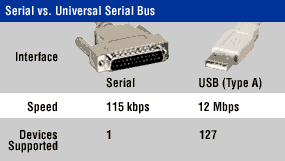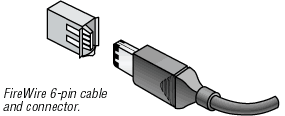| Services | Universal Serial Bus (USB) and FireWire USB
Technology Overview
A USB peripheral simply plugs right into the port and works. You don't need to install a card; you don't even need to turn off your computer—USB devices are completely hot-swappable. And because USB also distributes power, many USB devices don't require a separate power supply, although a bus-powered device must be attached upstream to either a host PC or a powered hub. Because USB configuration happens automatically, built-in USB means you don't have to fiddle with drivers and software when adding most peripherals. USB host controllers automatically detect when peripherals are connected to or disconnected from a port. The controllers manage and control the driver software and bandwidth required by each peripheral. They even allocate the right electrical power to each peripheral. USB uses a tiered star topology, meaning that USB devices called hubs can serve as connection ports for other USB devices. Only one device needs to be actually plugged into your PC. USB supports hubs that can be either standalone or embedded within some other device such as a keyboard or disk drive. A single USB port can support up to 127 devices. USB has two data rates: 12 Mbps for devices such as disk drives that need high-speed throughput and 1.5 Mbps for devices such as joysticks that need much lower bandwidth. A new specification, currently in development called USB 2.0, will increase speeds to 120 Mbps to 300 Mbps. USB also improves the performance of joysticks and other game controllers. A common problem with traditional joystick connections is the tendency to "drift" and lose calibration because of factors such as cable length and CPU overhead. The USB interface, however, prevents drift by effectively eliminating CPU overhead. When you buy your next PC, look for the capable, high-speed USB interface to ensure future performance and versatility. Or upgrade your current PC with USB cards available from office supply and computer supply companies. FireWire Technology Overview The IEEE 1394 standard is a fast, scalable, low-cost digital interface. It was conceived by Apple® Computer and developed within the IEEE 1394 Working Group. It is generally referred to as FireWire™— the Apple trademarked name—although other companies may use different names, such as I-link and Lynx, to describe IEEE 1394. FireWire promises to integrate personal computers with the world of consumer electronics. Because FireWire is an all-digital interface, there's no need to convert digital data into analog for data transmission. This leads to perhaps one of the most important uses of FireWire: as a digital interface for consumer electronics and AV peripherals. Because FireWire is a peer-to-peer interface, it makes it possible to dub from one device (a digital video camera, for instance) to another without a computer. It also enables multiple computers to share a given peripheral without any special support in the peripheral or the computers. FireWire supports data rates of 100, 200, and 400 Mbps. It supports up to 63 devices with a maximum cable length of 4.5 meters between devices. The maximum number of hops in a chain is 16 for a total maximum end-to-end distance of 72 meters. The IEEE 1394 standard supports daisychaining and branching or peer-to-peer implementations. Connections can be free-form, mixing branches and daisychains. In addition to its high speed, FireWire supports isochronous, as well as asynchronous, data delivery, providing a guaranteed data rate without lags or slowdowns. Because the standard supports guaranteed delivery of time-critical data, it enables applications to use smaller buffers, lowering costs. This makes it ideal for applications such as digital audio and video, which demand real-time data transfer. A FireWire interface combined with one of the new high-quality, low-cost DVD recorders enables a Macintosh user to capture broadcast-quality video. FireWire cable is lightweight, flexible, and inexpensive—a vast improvement over bulky and expensive SCSI cables. And, unlike many older interfaces, you never need device IDs, jumpers, DIP switches, screws, latches, or terminators. There are two types of FireWire connectors: 6-pin and 4-pin. The 6-pin connector, usually found on computers, provides two pairs of wires for signals and one pair of wires to provide power to external equipment. Many FireWire computer peripherals draw their power directly from the interface. Computer peripherals using 6-pin FireWire connectors generally feature at least two, and often three, FireWire connectors for daisychaining.
The 4-wire FireWire connector is usually found on consumer electronics such as camcorders, VCRs, and video game systems. It provides four signal wires but no power wires. Devices using the 4-pin FireWire connection generally have only one connector and aren't daisychained. When using a device such as a camcorder with your PC, you'll need a 6-pin-to-4-pin cable to convert the interface.
|
|
| ► | Software Development | |
| ► | Web Based Notification and Messaging | |
| ► | Network Design, Management, and Security | |
| ► | Network Backup and Continuity Planning | |
| ► | Remote Site and Incident Location Networking | |
| ► | Remote Access Solutions - VPNs | |
| ► | Database Server Management | |
| ► | Wireless Data Solutions | |
| ► | Rogue Wireless Data Detection | |
| ► | Firewall and Intrusion Detection Solutions | |
| ► | Network and Data Security | |
| ► | Automation Project Management | |
| ► | Web & Email Group Survey Systems | |
| ► | Data Mining - Data Analysis - Geocoding | |
| ► | Technology Consulting and Education Services | |
| ► | Seminar and Conference Organization and Management | |
| Products / Downloads | ||
|
► |
Software | |
|
► |
Hardware | |
|
► |
Policy Samples | |
|
Articles ► Articles Presentations |
||
| ► | Presentations | |
| Technical Documents | ||
| ► | Ethernet Overview | |
| ► | High Speed Networking | |
| ► | Frame Relay Overview | |
| ► | Fiber Optics | |
| ► | Routers and Bridges | |
| ► | Digital Subscriber Lines (xDsL) | |
| ► | Category 5 Cabling and Beyond | |
| ► | Serial Data Transmission | |
| ► | Universal Service Ordering Code (USOC) | |
| ► | Universal Serial Bus (USB) and Firewire | |
| ► | dBm to Watt Conversion | |
| Company Information | ||
| ► | About CPCS Technologies | |
| ► | Contact Information | |
| Links / Resources | ||
|
► |
Additional Resources | |
|
|
||

